Gynecomastia Type 2: Chest Angle Less than 45°
Definition
Excess breast tissue is located diffusely across the chest. Chest skin is tight. Chest angle is less than 45 degrees.
- Overview of Gynecomastia
- Causes of Gynecomastia
- Ideal male chest
- Joseph T Cruise, MD's Gynecomastia Philosophy
- 7 Types of Gynecomastia
- 1-Puffy nipple. Breast tissue outside of areola
- 2-Chest angle less than 45 °
- 3-Chest angle 45-60° Mild breast sag
- 4-Chest angle 60-90° Moderate breast sag
- 5-Chest angle greater than 90° Significant sag
- 6-Top of areola is above chest fold. Severe sag
- 7-Top of areola is below chest fold. Extreme sag
- Are You a Good Candidate?
- Benefits of Male Breast Reduction
- Components of Gynecomastia
- Classic Gynecomastia
- Puffy Nipples
- Fatty Gyecomastia
- Saggy Gynecomastia
- Breast Roll
- Prior to Male Breast Reduction
- Male Breast Reduction Anesthesia
- After the Male Breast Reduction
- Recovery from Male Breast Reduction
- Possible Complications
- Gynecomastia Cost and Financing
- Gynecomastia Words to Know
- Gynecomastia Before and After Pictures
Physical Exam/Description
Type 2 gynecomastia is perhaps the most common gynecomastia treated by plastic surgeons. It is characterized by excess breast volume that fills the entire lower chest. This volume may be glandular or fatty. Typically, the volume beneath the areola is firm and is more likely to be glandular. As you go away from the areola the volume is more likely to become fatty. It is very important from a surgical standpoint for the surgeon to assess the margins of the excess breast tissue. Often, the surgeon does not know whether the excess tissue is glandular or fatty until he/she is operating. The reality is it does not really matter. Either way, it needs to be removed. It is important, however, for the surgeon to know where the margins of the excess tissue are.
The total volume removed during a Type 2 surgery is often equivalent to a tennis ball from each side and may be as much as a soft ball. If the chest is primarily fatty, liposuction alone may be capable of removing it. The problem often seen with using liposuction alone is that if there is glandular tissue (usually directly below the areola), this glandular tissue will be left behind. For this reason, many gynecomastia surgeons surgically remove this sub-areola tissue even if they liposuction the rest of the chest.
Gynecomastia Type 2
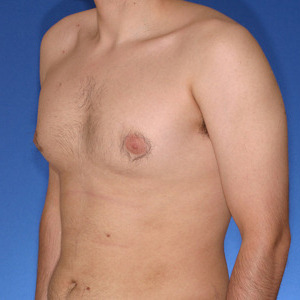
Type 2 gynecomastia is typically seen in 20-30 year-olds. These patients are ideal candidates for surgery because their skin quality is very good. This allows the skin to "snap back" when the excess breast tissue is removed. This is what separates a type 2 from a type 3. A type 3, by definition, has looser skin. Type 2 may be composed of glandular tissue, fatty tissue, fibrous tissue, or a combination of all three. While fatty tissue will decrease with weight loss, glandular tissue will not.
Gynecomastia is a common finding among teenagers as they go through puberty. Often, the excess breast volume will decrease by the late teens. However, if the problem persists for greater than 2 years it is less likely to go away spontaneously and surgery may be indicated.
The image below outlines the 7 types of gynecomastia. Types 1 is Puffy Nipple. Types 2-5 are determined by the chest angle. Types 6 and 7 are determined by the position of the nipple in relation to the chest fold.
Gynecomastia Types
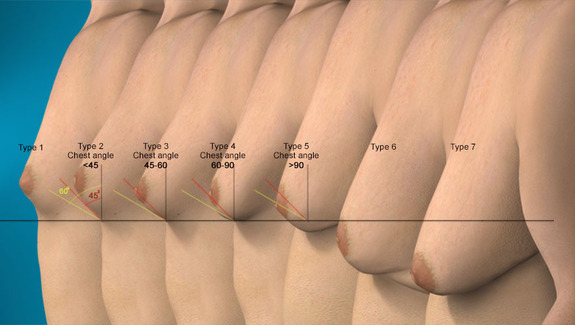
The purpose of categorizing gynecomastia is to determine what type of surgery is necessary to correct a given problem. Joseph T Cruise, MD has developed this classification system based on the extensive work he has done with gynecomastia patients. Other surgeons may use other methods.
Here is how the type of surgery changes depending on the gynecomastia type.
Type 1 - Incision at lower margin of areola
Type 2 - Incision at lower margin of areola
Type 3 - Incision at lower margin of areola or donut lift
Type 4 - Donut lift or anchor lift
Type 5 - Anchor lift
Type 6 - Anchor lift or free nipple graft
Type 7 - Free nipple graft
Here is an enlarged view to show the differences between Types 2-5. The reason why these are grouped together is because the differences are relatively close but they are enough to change the type of surgery necessary to obtain a good result.
Skin laxity differences between types 2-5
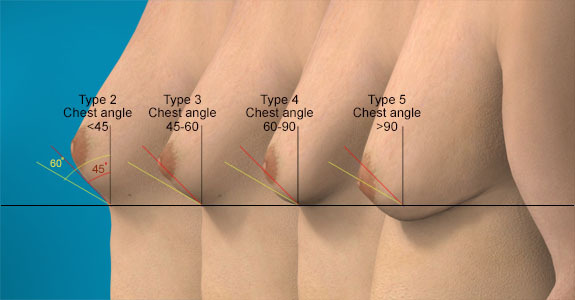
Diagnosing a Type 2,3,4 and 5 gynecomastia. The major difference between the different types is not so much the volume, but rather the skin excess. As you go up, the amount of skin excess increases. This increase in skin excess changes the procedure necessary to correct it. With increasing skin excess, the chest will sag more. This will result in the Chest Fold Angle (CFA) getting smaller and smaller as shown above. Keep in mind, when the breast volume is removed the chest will deflate causing significantly more chest sag. This will further increase the need for skin removal. Failure to address the skin laxity may make the sagginess worse. Fortunately, for type 2 gynecomastia, the chest will likely "snap back" without any skin removal.
- Type 2
- Type 3 45-60 degrees
- Type 4 60-90 degrees
- Type 5 >90 degrees
Surgical implications
- Liposuction
May or may not be useful to remove breast tissue depending on whether or not it composed of fatty tissue or glandular tissue. - Surgical removal of breast tissue
Surgical removal of breast tissue is often method of choice to ensure that all necessary breast tissue is removed. Liposuction may or may not be done in conjunction with breast tissue excision. - Skin removal
Skin removal is not necessary.
Type 2 gynecomastia
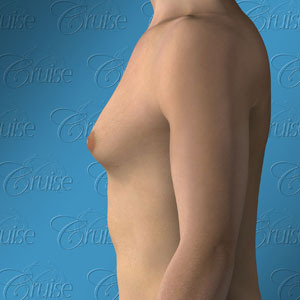
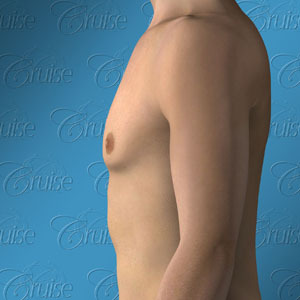
Notice the projection of the entire chest not just the areola area. The skin is relatively tight. Removing the excess volume will flatten the breast mound. Typically with a Type 2 the skin quality is such that the skin will snap back when the volume is removed. As you go to Types 3, 4, and 5 the skin does not snap back as well. This is why skin tightening may be necessary in these types.
Preferred incision for Type 2
Type 1 - Incision at lower margin of areola
Type 2 - Incision at lower margin of areola
Type 3 - Incision at lower margin of areola or donut lift
Type 4 - Donut lift or anchor lift
Type 5 - Anchor lift
Type 6 - Anchor lift or free nipple graft
Type 7 - Free nipple graft
Type 2 gynecomastia incision location
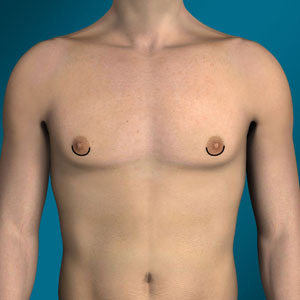
The image above demonstrates the most common incision location to correct Type 2 gynecomastia. If only liposuction is performed this incision may be much smaller or may be located elsewhere on the chest.


